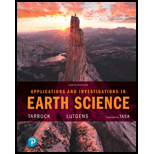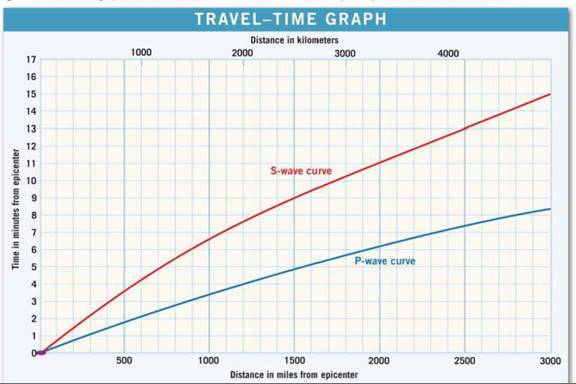
Applications and Investigations in Earth Science (9th Edition)
9th Edition
ISBN: 9780134746241
Author: Edward J. Tarbuck, Frederick K. Lutgens, Dennis G. Tasa
Publisher: PEARSON
expand_more
expand_more
format_list_bulleted
Textbook Question
Chapter 4.2A, Problem 1A
Examine Figure 4.41 Does the difference in the arrival times of the first P wave and the first S wave on a seismogram Increase or decrease the farther a station IS from the epicenter?
The difference in arrival times _____ the farther a station is from the epicenter
Figure 4.4 Travel-time graph used to determine the distance between an earthquake epicenter and a seismic station.

Expert Solution & Answer
Trending nowThis is a popular solution!
Learn your wayIncludes step-by-step video

schedule04:57
Students have asked these similar questions
A 40-cm circular PPC pile is driven to a depth of 20 meters in the soil conditions shown
below. Calculate the (a) shaft resistance in the clay layer using the alpha method and the
(b) shaft resistance in the sand layer using the beta method.
Depth (m)
14
20
30
Stiff Clay
y = 19.8 kN/m³
Su = 130 kPa
a = 0.58
20-
Dense Sand
y = 18.8 kN/m³
Q=35º
8 = 2/34
Figure 12.7:
A.
B.
A.
B.
C.
D.
E.
Chapter 4 Solutions
Applications and Investigations in Earth Science (9th Edition)
Ch. 4.1 - How many minutes elapsed between the arrival of...Ch. 4.1 - How many minutes elapsed between the arrival of...Ch. 4.1 - How much time elapsed between the arrival of the...Ch. 4.1 - Is the maximum amplitude wave height of the...Ch. 4.2A - Examine Figure 4.41 Does the difference in the...Ch. 4.2A - Use Figure 4.4 to determine the difference in...Ch. 4.2A - What is the distance between the epicenter and the...Ch. 4.2A - For the earthquake recorded in Figure 4.2, about...Ch. 4.2A - If the first P wave was recorded at 10:39 P.M....Ch. 4.2B - Use Figure 4.5 and the travel-time graph in Figure...
Ch. 4.2B - Use Figure 4.6 and a drafting compass to draw a...Ch. 4.2B - What are the approximate latitude and longitude of...Ch. 4.2B - The first P wave was recorded in New York at 9:01...Ch. 4.3 - Use Figure 4.7 to answer the following questions a...Ch. 4.3 - At what depth shallow, Intermediate, or deep do...Ch. 4.3 - With what geologic feature are the earthquakes in...Ch. 4.3 - What name is given to the zone of greatest seismic...Ch. 4.4 - Does the velocity of P waves and S waves increase...Ch. 4.4 - What are the approximate velocities of P and S...Ch. 4.4 - Does the velocity of P waves and S waves increase...Ch. 4.4 - Does the change in velocity of seismic waves as...Ch. 4.4 - How does the velocity of seismic waves change with...Ch. 4.4 - Does the change in velocity of seismic waves with...Ch. 4.4 - What happens to S waves when they reach the outer...Ch. 4.4 - Do P waves increase or decrease in velocity as...Ch. 4.4 - What are the approximate velocities of P and S...Ch. 4.4 - What are the approximate velocities of P and S...Ch. 4.4 - Prob. 11ACh. 4.5 - Plot the temperature values from Table 4.2 on the...Ch. 4.5 - Referring to the graph, does Earth sinternal...Ch. 4.5 - Is the rate of temperature Increase from the...Ch. 4.5 - Is the temperature at the base of the lithosphere,...Ch. 4.6 - Plot the melting temperatures for wet granite and...Ch. 4.6 - At approximately what depth does wet granite reach...Ch. 4.6 - Oceanic crust and the underlying rocks to a depth...Ch. 4.6 - Referring to Figure 4.10, at approximately what...Ch. 4.6 - Referring to Figure 4.9, what is the name of the...Ch. 4.6 - Does the graph you constructed support or refute...Ch. 4 - Explain the difference between a seismograph and a...Ch. 4 - Use Figure 4.11 to sketch a typical seismogram in...Ch. 4 - Use Figure 4.4 and Figure 4.11 to determine the...Ch. 4 - List the three zones around the globe where most...Ch. 4 - The velocity of S waves decreases as these waves...Ch. 4 - Explain why S waves do not travel through Earths...Ch. 4 - Use Figure 4.8 to complete the following about...Ch. 4 - Prob. 8LRCh. 4 - What is the location directly above an earthquake...Ch. 4 - Label Earths major layers on Figure 4.12, using...
Additional Science Textbook Solutions
Find more solutions based on key concepts
Why are the top predators in food chains most severely affected by pesticides such as DDT?
Campbell Essential Biology (7th Edition)
Endospore formation is called (a) _____. It is initiated by (b) _____. Formation of a new cell from an endospor...
Microbiology: An Introduction
1. a. Can a vector have nonzero magnitude if a component is zero? If no, why not? If yes, give an example.
b. C...
College Physics: A Strategic Approach (3rd Edition)
Why do researchers identify the charophytes rather than another group of algae as the closest living relatives ...
Campbell Biology (11th Edition)
123. A sample contains both KBr and KI in unknown qualities. If the sample has a total mass of and contains , ...
Introductory Chemistry (6th Edition)
Name each of the following:
Organic Chemistry (8th Edition)
Knowledge Booster
Similar questions
- A) List and describe the six stages that led to the formation of Earth. 1. Nebular stage Gravity caused collapse of a rotating mass of dust and gas. 2. A star forms 3. Planetesimals form 4. The Sun ignites 5. Inner planets 6. Outer planets B) What does the presence of banded iron formation tell us about conditions in the early atmosphere and oceans? (Short answer , couple of sentences) C)What does the sediment core from Walvis Ridge, southern Atlantic Ocean, from 55-56 million years ago tell us about past climate? (Short answer , couple of sentences )arrow_forwardA) List three things that can be measured from annual layers of ice cores. 1 2 3.arrow_forward1. Use the descriptions of shoreline features provided above to label the structures in Figures 12.5 and 12.6. The same feature may appear more than once. 2. Next to each of the features listed below, indicate whether it is the result of erosional or depositional processes.Sea stack: Wave-cut cliff:Spit:Barrier island:Baymouth bar:Marine terrace:arrow_forward
- Activity 12.5B: Identifying Shoreline Features on a Topographic Map Pg 209The area shown on the Point Reyes, California, topographic map is located directly to the southwest of the San Andreas Fault, in a very tectonically active region (Figure 12.10). As a result, some of this region has recently been uplifted and exhibits characteristics of an emergent coastline. On the other hand, because of the general rise in sea level over the past several thousand years, other areas exhibit features associated with submergent coastlines. Refer to this topographic map to complete the following. 1. What type of shoreline feature is Drakes Estero (located near the center of the map)? 2. Point Reyes, located in the bottom-left corner of the map, is a headland undergoing severe wave erosion. What type of feature is Chimney Rock, located off the shore of Point Reyes? 3. Several depositional features near Drakes Estero are related to the movement of sediment by longshore currents. What type of…arrow_forwardActivity 12.3: Wave Refraction Pgs 202-203Figure 12.2 is a map view of a headland along a coastline. The water depths are shown by blue contour lines. As you complete the following questions, assume that waves with a wavelength of 60 feet are approaching the shoreline from the bottom left of the figure. 1. At approximately what water depth-10, 20, 30, or 40 feet-will the approaching waves begin to touch bottom and slow down? (Hint: Recall that this occurs when the water depth is one-half the wavelength.) 2. Using the wave shown in Figure 12.2 as a starting point, sketch a series of lines to illustrate the wave refraction that will occur as the wave approaches the shore by following these steps:Step 1: Mark the position on the 30-foot contour line where the wave front will first touch bottom.Step 2: Knowing that the section of the wave that touches bottom will slow down first, sketch the shape of the wave front when it reaches the 20-foot contour line.Step 3: Using the same…arrow_forwardCan trace and tell me how they did itarrow_forward
- Can someone show me how they would trace thisarrow_forwardI need help with this part E.arrow_forwardDiscussion Question: Ecosystems Essentials A+ shof 1000 Exo-spil The Human Denominator Assignment As we learn about how the earth works, we learn to identify the different earth spheres and how they overlap and affect one another. An understanding of the Earth's systems and spheres takes practice. More importantly, we can see the "Domino Effect" of the spheres as they interact with one another. We have learned that while endogenic processes are separate from exogenic process, the lithosphere affects the atmosphere which affects the hydrosphere, and thearrow_forward
arrow_back_ios
SEE MORE QUESTIONS
arrow_forward_ios
Recommended textbooks for you
 Applications and Investigations in Earth Science ...Earth ScienceISBN:9780134746241Author:Edward J. Tarbuck, Frederick K. Lutgens, Dennis G. TasaPublisher:PEARSON
Applications and Investigations in Earth Science ...Earth ScienceISBN:9780134746241Author:Edward J. Tarbuck, Frederick K. Lutgens, Dennis G. TasaPublisher:PEARSON Exercises for Weather & Climate (9th Edition)Earth ScienceISBN:9780134041360Author:Greg CarbonePublisher:PEARSON
Exercises for Weather & Climate (9th Edition)Earth ScienceISBN:9780134041360Author:Greg CarbonePublisher:PEARSON Environmental ScienceEarth ScienceISBN:9781260153125Author:William P Cunningham Prof., Mary Ann Cunningham ProfessorPublisher:McGraw-Hill Education
Environmental ScienceEarth ScienceISBN:9781260153125Author:William P Cunningham Prof., Mary Ann Cunningham ProfessorPublisher:McGraw-Hill Education Earth Science (15th Edition)Earth ScienceISBN:9780134543536Author:Edward J. Tarbuck, Frederick K. Lutgens, Dennis G. TasaPublisher:PEARSON
Earth Science (15th Edition)Earth ScienceISBN:9780134543536Author:Edward J. Tarbuck, Frederick K. Lutgens, Dennis G. TasaPublisher:PEARSON Environmental Science (MindTap Course List)Earth ScienceISBN:9781337569613Author:G. Tyler Miller, Scott SpoolmanPublisher:Cengage Learning
Environmental Science (MindTap Course List)Earth ScienceISBN:9781337569613Author:G. Tyler Miller, Scott SpoolmanPublisher:Cengage Learning Physical GeologyEarth ScienceISBN:9781259916823Author:Plummer, Charles C., CARLSON, Diane H., Hammersley, LisaPublisher:Mcgraw-hill Education,
Physical GeologyEarth ScienceISBN:9781259916823Author:Plummer, Charles C., CARLSON, Diane H., Hammersley, LisaPublisher:Mcgraw-hill Education,

Applications and Investigations in Earth Science ...
Earth Science
ISBN:9780134746241
Author:Edward J. Tarbuck, Frederick K. Lutgens, Dennis G. Tasa
Publisher:PEARSON

Exercises for Weather & Climate (9th Edition)
Earth Science
ISBN:9780134041360
Author:Greg Carbone
Publisher:PEARSON

Environmental Science
Earth Science
ISBN:9781260153125
Author:William P Cunningham Prof., Mary Ann Cunningham Professor
Publisher:McGraw-Hill Education

Earth Science (15th Edition)
Earth Science
ISBN:9780134543536
Author:Edward J. Tarbuck, Frederick K. Lutgens, Dennis G. Tasa
Publisher:PEARSON

Environmental Science (MindTap Course List)
Earth Science
ISBN:9781337569613
Author:G. Tyler Miller, Scott Spoolman
Publisher:Cengage Learning

Physical Geology
Earth Science
ISBN:9781259916823
Author:Plummer, Charles C., CARLSON, Diane H., Hammersley, Lisa
Publisher:Mcgraw-hill Education,